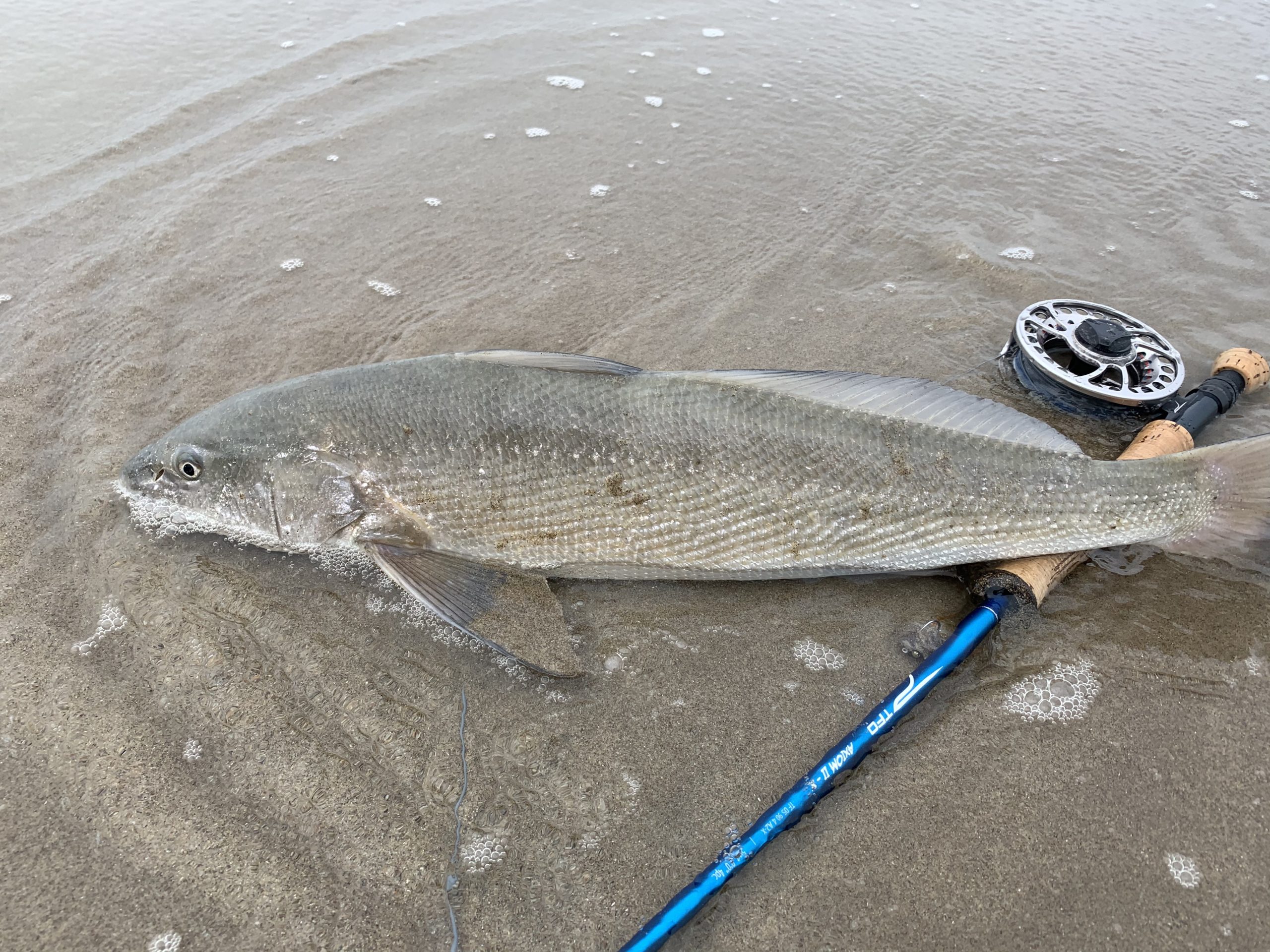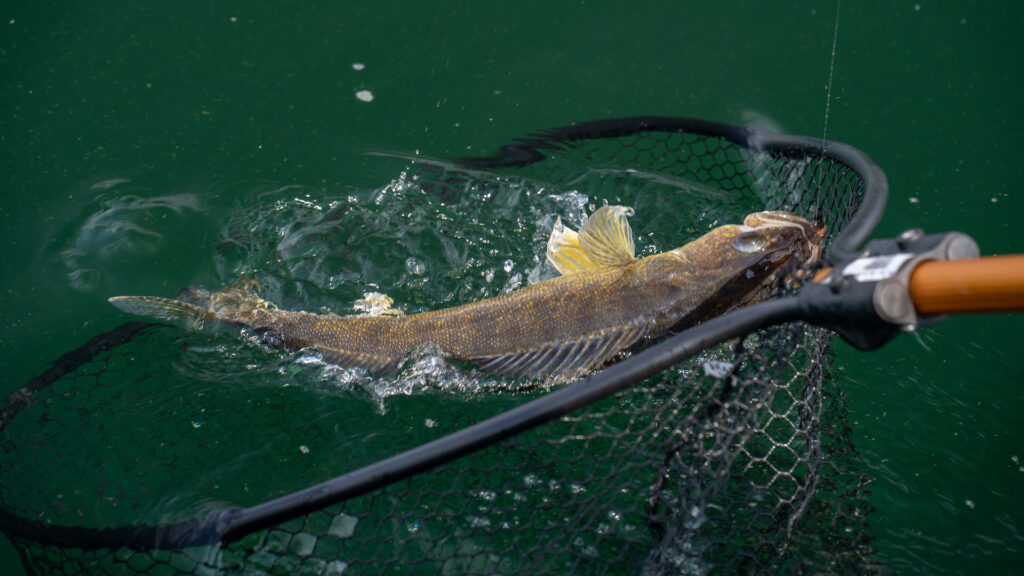“Don’t get too deep. No more than ankle deep at most,” I remember Nick Curcione telling me on a beach in Coronado years ago. It didn’t make sense until the first one I saw bolted between my legs from behind me in three inches of water. “I told you,” came his response. That began an obsession and a quest that has pulled me from the Mexican border to Santa Barbara almost every summer since. All for a shot at the “ghost of the coast.”
There are numerous axioms associated with the sport of fly fishing, and fishing in general. If you fish the surf in Southern California, you’ll hear a few specific to one of the most difficult and rewarding species you can chase on fly: the California corbina. This member of the croaker family, known throughout SoCal as a “bean,” ranks along with permit and white marlin in its finicky and frustrating nature. And like those other species, taking one is a prize well earned and worth every drop of blood, sweat and tears shed in its pursuit.
Chasing corbina is a summertime pursuit, however, depending on conditions, they can be taken from early spring into late fall, from the northern reaches of the Baja Peninsula up to Santa Barbara. Traditionally, those hardcore enthusiasts that chase them say that when the jacaranda trees bloom, its time to chase beans, but knowing what time of year they are supposed to show up barely answers the question of “when.”
With any shallow water or surf species, tide and time of day are critical. Beans ride the surf in and out, chasing sand crabs, clams, worms and small baitfish, and in doing so, depend on the tide to make much of their diet accessible. At low tides, crab, clam and even worm beds are often high and dry, or in such skinny water that they are inaccessible to most fish. Like bonefish, permit, and even redfish, as the tide begins to rise, flooding the beach, beans push up farther up the beaches in pursuit of prey. In general, big tides allow greater opportunity, but experience will teach you when exactly in the tidal swing your favorite beach fishes best. In some cases, beans prefer the last of the falling and first of the rising tide. On other beaches they will feed on all but the lowest tides, but the safe bet is always begin your search on the incoming, or rising, tide during the summer months.
Keep in mind that tides around the full moon are larger than those on the new moon. Just as important to the state of the tide is the time of day the lows and highs occur. Remember, the highest form of chasing beans is sight fishing, so ideally, the best tides to fish are early in the day, but with enough sunlight to allow fair visibility. Sure, you can catch them blind casting, and arguably, most beans are taken while doing so, but for those that prefer to test their skill and patience, sight fishing for corbina is the acme of achievements. It’s not just their permit-like persnickety nature. They will ignore a well-presented fly with the same willful nonchalance of a teenager at a family event, only to nearly beach itself to grab a fly about to be picked up and re-cast.
Their behavior is bad enough, but when you add onto that the dynamic nature of their environment, sometimes the quest almost feels futile. They ride the incoming surf to push farther up the beach in pursuit of food and dart back to deeper water the instant the water ebbs. But the surf is never a simple ebb and flow. Waves compound themselves, break at odd angles and roll in heavily on one set and dribble in the next. The beaches along the Pacific coast are often deep very close to shore, and those troughs make perfect staging grounds for beans waiting to charge the beach. As the waves roll in, they dart up the beach, digging, rooting and often tailing if the water is deep enough, and, as the surf begins its withdrawal, in the blink of an eye they are gone.
Their nickname “ghost of the coast” is well deserved. Just as you line up the perfect shot, the light shifts, a wave breaks, and they disappear, sometimes to reappear ten feet farther down the beach, or sometimes they disappear altogether. Your window of opportunity can be timed in seconds that can be counted on one hand with fingers left to spare.
Add to this frustration that these fish squeeze into the shallowest of conditions. Another corbina axiom is if your feet are wet, you’re too deep. I’ve had beans square in my sights twenty feet in front of me, as a six-inch wave rolls through only to see the wake of a skittish fish darting back to deeper water from three feet behind me. Understandably, good light is critical to seeing these fish in the surf. Since most of our beaches here in SoCal face west, or mostly west, morning light works best to keep the sun over your shoulder rather than glaring in your face. The only issue with that is the May Gray and June Gloom—a heavy inversion layer of fog and mist that blots out the sun along the coast practically daily, often until late July. Under these conditions, the best you can hope for is spotting “signs” of a bean’s presence: wakes, tailing fish, or the bronze backs protruding from the surf as they push shallower, or more likely, head for deeper water.

Photo: Scott Leon
As if that all isn’t disheartening enough, you have to remember that SoCal beaches are hardly isolated or remote. Indeed, some of the best corbina fishing lies in the very heart of Los Angeles. Try making a back cast with scores of tourists trying to take photos of the sunrise, kids darting into the surf, joggers shuffling past, and dodging surfers like that digital frog in that old video game, all while jockeying for position among other anglers. None of these bystanders seem aware of your backcast, meaning that for safety’s sake you always have to watch behind you while trying to keep an eye on a wary, wiley target in front of you.
Maddening.
And then you hook one…

Photo: Scott Leon
If I haven’t yet dissuaded you from chasing beans, the the gear you’ll need is simple and straightforward. I prefer a stout rod capable of delivering quick casts at any range, though most casts will be shorter than 50 feet. My go-to is the Axiom II-X in a 5-weight. Many anglers prefer a 6 or even a 7-weight rod, but I think the A2-X is plenty beefy in the 5. The LK Legacy is also a great choice as is the new Mangrove Coast. A reel with a sealed drag is critical because of the sand and surf, making the BVK SD an ideal choice for beans.

Photo: Scott Leon
As for lines, I prefer a sinking line over an intermediate line because I feel the intermediate gets washed around too much by the surf, pulling the fly along with it. The sinking line keeps the fly in the zone within the washing machine on the beach. Shooting heads were the standard for years by those who pioneered the fishery, like fellow TFO Advisory staffer Nick Curcione, who began chasing these fish decades ago, but the newer integrated sinking lines are easier to handle in my opinion. There are even surf lines produced by several manufacturers, designed by SoCal surf fishermen for this specific application. I prefer a triple density line, however, but the choice is very much one of comfort and personal preference. A stripping basket, like the Linekurv, will help you keep your line, and your sanity, under control as you stalk the beaches and is an essential piece of equipment for surf fishing.
Leaders are even simpler. I used 8 to 10 feet of 8-pound mono or fluorocarbon. You could use 10 or even 12-pound test, but I feel lighter is better and I’m comfortable with 8. These fish are already spooky enough. Just remember to check your leader often. The surf and sand can wreck the material, quickly making a once clear material an opaque white cord. Fly choice is controversial and depends on who you ask—if they are even willing to tell you. Surf Merkins and sand crab patterns in bright pink or grey work best. You want them to be weighted, but not overly so, because the “plop” will undoubtedly spook beans. You need some weight, however, to keep the fly anchored to the bottom during your retrieve. Most tiers include a hint of orange along the bottom or back of the fly, mimicking an egg sack. Sizes should not be larger than a 4 but don’t need to go smaller than a 6, either. Stout hooks are necessary because beans pull. Hard. Sharpen your hooks often, too. Dragging through the sand will dull even the sharpest hook in minutes, and you’ll need a solid strip-strike and a sharp hook to penetrate the rubbery lips of a bean.

Top and bottom view of a sand flea. // Photo: Scott Leon
Over the past few seasons, I’ve seen more and more fly anglers hitting the beaches here in SoCal in search of the elusive bean. It’s a challenging pursuit well worth exploring, and a prey worthy of any angler, no matter how skilled they think they are. Beans will humble you. The challenge is not for everyone, but the great thing about them is they are readily accessible to everyone. A little grit and determination, a good rod, and a heap of patience is all that’s required.
Blog written and photos provided by TFO Ambassador Scott Leon.

Blog author Scott Leon with a corbina caught on his 5wt Axiom ll-X // Photo: Scott Leon
![]()






